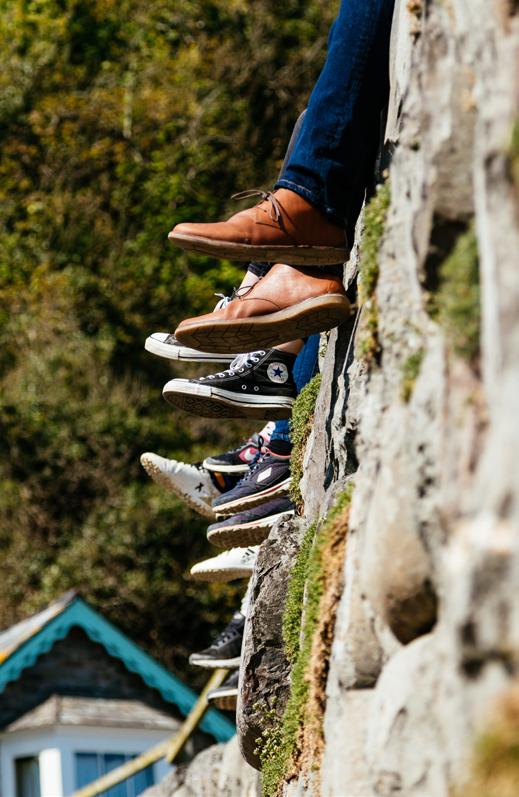
3 minute read
What is circular economy?
3 reasons to shift to circular economy training in entrepreneurship
Finland’s government programme for 2019 states that Finland should be a socially, economically and ecologically sustainable society by 2030. Likewise, according to the Finnish National Agency for Education’s forecast forum in 2019, sustainable development will determine new changes in the structure of know-how. Circular economic thinking responds to know-how needs of the future by directing creative problem solving into scenarios where both economic and environmental benefit is desired. Because of this, the societal benefits of circular economic thinking combined with training young people in the work life skills needed in the future are key to achieving the governmental programme's goals.
Advertisement
The ReWi Visions manual guides young people towards entrepreneurial activities and creates a basis for lifelong learning. The model presented in this manual provides young people with abilities that will support them in facing a changing world. The following list features three core reasons for why now is the time to move from business upbringing to the entrepreneurial upbringing of circular economy. be brrrrave!
1. Answering the challenges of climate change
The challenges of climate change have become part of modern life, changing work life as well. According to the Finnish National Agency for Education’s 2019 forecast forum, the work life skills of the future require circular economic and systemic thinking, as well as creative problem solving skills. Through circular economy, young people will learn to develop solutions to the challenges of climate change.
2. Solving societal problems
Climate change is a prominent worry among young people, who are now keener to react to it politically. According to the 2019 youth barometer, young people’s interest toward entrepreneurship has increased, which shows that young people are ready to back up their words with actions. Circular economic thinking enables new companies to be founded based on business ideas that promote sustainable development.
3. Facing the turning point in work life
Work life is in a turning point, in which entrepreneurship is becoming more common than before. Sitra’s megatrends 2020 report challenges educational developers to improve their ability to train young people to face this change. The training should focus on strengthening so-called generic skills which help young people operate in work life in an entrepreneurial way.
Education is a key resource
Entrepreneurial business is predicted to increase in the future. A significant portion of people are expected to employ themselves as entrepreneurs by 2030. This accelerating change of work life challenges educational organizers to pay more attention to learning the work life skills of the future and entrepreneurship as a form of employment. These so-called generic skills are necessary for finding employment in all fields in the future. The effectiveness of education is evaluated by how well a school can prepare a student for work life, finding their place in it and from there on into further education as well as operating according to the principles of sustainable development and entrepreneurship.
Guidelines of sustainable development for the administrative field of the Finnish Ministry of Education and Culture: https:// julkaisut.valtioneuvosto.fi/handle/10024/162183 Read the know-how forecast forum publication here: https:// www.oph.fi/fi/tilastot-ja-julkaisut/julkaisut/osaaminen-2035
What is circular economy?
Circular economic thinking engages young people into participating in the most challenging and complicated questions of global economy: how to shift from linear “take-make-waste”
form of production and consumption toward waste-free econ-
omy? Circular economy attempts to maximize the value of products and materials tied to them within economy for as long as possible. In circular economy, production and consumption create as little waste as possible.
It means not just recycling, but an operating model for all activities.”
raw materials
waste
recycling Circular economy design
production
collection
use distribution
CIRCULAR ECONOMY IS A RENEWABLE SYSTEM IN WHICH
• The use of resources and energy is maximized to minimize waste. New, more efficient ways to use resources are discovered.
• Circular economy attempts to maximize the value of products, components, materials and the value bound to them within economy for as long as possible.
• In circular economy, consumption is based on the usage of services: sharing, renting and recycling new items instead of production and ownership.
Circular economy is about more than just recycling. In includes the entire production process from raw materials, processing, manufacturing, distribution and sales. These are all realized in a way that minimizes the waste from the product's life cycle and allows its materials to be reused in new products.
Did you know that Sitra has published a roadmap for circular economy in Finland in 2019? The roadmap allows different operators to strive for the goals of sustainable development together. Link: https://www.sitra. fi/hankkeet/kriittinen-siirto-kiertotalouden-tiekartta-2/









